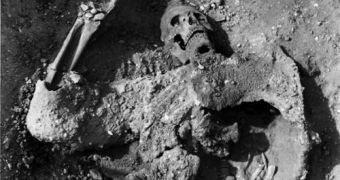A team of archaeologists investigating the location of the former Syrian city of Dura-Europos stumbled across indications that 19 Roman soldiers found dead in the ruins were killed with an ancient form of chemical warfare.
At the time of their deaths, around 2,000 years ago, the soldiers were defending the city, which was held by the Roman Empire. Historical accounts show that the garrison was up against a large army of Persian warriors.
The city, surrounded by mudbrick walls, was especially vulnerable from below, and the Persians were digging a tunnel to pass underneath the structures. The 19 Roman soldiers went in to kill the invaders.
But they did not meet anybody. Upon entering the tunnel, they were met by a black curtain of poisonous smoke, which turned to acid inside their lungs as soon as it was inhaled. All soldiers died within less than a minute, experts say.
The theory that this was an early chemical attack is supported by the discovery of a dead Persian soldier nearby. It is believed that he was responsible for starting the poisonous fire, and that he may have also killed himself in the process.
According to the experts, all 20 men died in AD 256, LiveScience reports. This is the first documented case of chemical warfare that left tangible traces behind. The ground under the ancient city revealed a large number of tunnels and mines.
It is believed that the Persians and the Romans were both digging under the walls, in a bid to intercept each other's tunnels. Early archaeologists believed in the 1920s and 1930s that the Roman soldiers were killed in hand-to-hand combat.
But that did not sit right with University of Leicester archaeologist Simon James. “This wasn't a pile of people who had been crowded into a small space and collapsed where they stood. This was a deliberate pile of bodies,” he explained.
After looking over old maps of the tunnels, the expert hypothesizes that the Persians digging the tunnel heard the Romans approaching. When the two groups met, the former used bitumen and sulfur to light a toxic fire that killed everyone.
“It would have almost been literally the fumes of hell coming out of the Roman tunnel,” James says.
“It's a circumstantial case. But what it does do is it doesn't invent anything. We've got the actual stuff [the sulfur and bitumen] on the ground. It's an established technique,” the expert adds.

 14 DAY TRIAL //
14 DAY TRIAL //